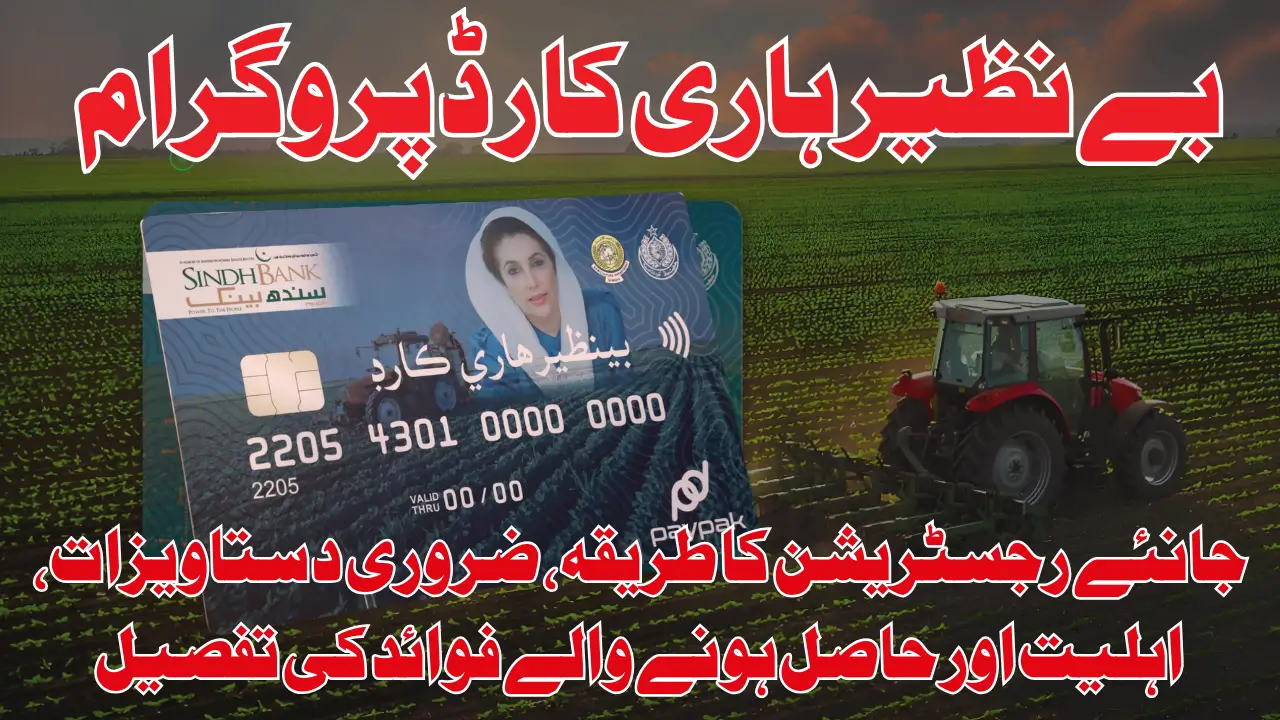Benazir Hari Card Phase 3 2025
Benazir Hari Card Phase 3 2025: The Sindh Government has launched Benazir Hari Card 2025 Phase 3 to strengthen small-scale farming and empower rural communities. This initiative builds on earlier phases and continues to provide direct support in the form of subsidies on seeds, fertilizers, and interest-free loans. By introducing biometric verification, banking services, and digital record systems, the government is ensuring transparency and smooth delivery of benefits.

Phase 3 has been specially designed to cover more farmers across Sindh. The target is not only to improve agricultural productivity but also to secure livelihoods, promote financial inclusion, and create long-term rural prosperity.
Also Read: 8171 Web Portal Update September 2025 To Verify Payment Know the Government’s New Method
Objectives of Benazir Hari Card Phase 3
The third phase of this program carries forward its main goal: uplifting farmers through financial, technical, and social support. With millions of farmers depending on agriculture as their only source of income, direct government assistance can help reduce financial stress and increase food production.
Key objectives of Phase 3 include:
- Provide subsidies on essential farming inputs.
- Offer interest-free loans to small farmers.
- Expand farmer registration to cover 1.4 million families.
- Digitize records to eliminate duplication and fraud.
- Encourage self-cultivation and sustainable farming practices.
Unlike traditional aid programs, the Hari Card links farmers directly with banking services. This means fewer middlemen, faster payments, and more transparency in subsidy distribution.
Also Read: BISP Taleemi Wazaif September 2025 From 2500 To 5000 For School And College Students Of Pakistan
Required Documents For Application
Farmers applying for the Benazir Hari Card 2025 Phase 3 must prepare all required documents in advance. Having these ready makes the registration process quicker and smoother.
Required Documents:
- Original CNIC + photocopy or clear scan.
- Proof of land ownership (fard, deed, khasra, survey extract, or mutation).
- Tenancy/sharecropping agreements (if applicable).
- List of household members with relation, gender, and exact age.
- Mobile number (active, registered, and proof if needed).
- Recent utility bill or house ownership document (if asked).
- Notes about crops, yields, and receipts from past seasons.
Also Read: 8171 Ehsaas Program Phase 3 September 13500 Announced For NSER Completed Beneficiaries
Registration Process for Farmers
The government has made the application process simple, but it must be done carefully. Every detail matters, from CNIC digits to land survey numbers. Farmers can register online or at designated centers by submitting personal, household, and landholding details.
Personal Information
- Go to https://www.benazirharicard.gos.pk/ and click on the farmer registration option
- Write full name (as per CNIC).
- Enter father/husband name.
- Enter surname.
- Write CNIC number in proper format.
- Select CNIC status (valid/expired).
- Enter CNIC issue date.
- Enter CNIC expiry date.
- Enter mobile number in proper format.
- Fill in district name.
- Fill in taluka name.
- Fill in union council name.
- Fill in tappa name.
- Fill in deh name.
- Fill in village name.
- Tick gender (male/female).
- Select owner type.
- Enter family composition (male/female, children <18, adults >18).
- Enter next of kin full name.
- Enter next of kin CNIC number.
- Enter next of kin mobile number.
- Select house type (pakka/kacha).
- Enter total landholding (acres).
- Enter total area with hari(s) (acres).
- Enter total self-cultivated land (acres).
- Enter total fallow land (acres).
- Enter share details.
- Enter area as per share.
- Write survey number(s). (If more than one, click “Add” button to enter multiple survey numbers).
- Fill particulars of tenants/sharecroppers (name, father name, CNIC, contact, area). (If more than one tenant, click “Add” button to enter each separately).
- Enter crop status (season, orchard/crop, area, average yield). (If more than one crop/season, click “Add” button to record all details).
- Review all entries carefully.
- Attach required documents (CNIC, land papers, tenancy proofs).
Submit the form and get a receipt/confirmation, and click on the next button. Then provide the following information
- Assets Information
- Sources of Income
- Bank & Account Details
- Upload Documents
At the end, attach scanned documents, double-check all fields, and submit either online or at the local registration office.
Information Required in the Application
The form collects both personal and agricultural information. This ensures fairness and helps the government assess real needs before approving subsidies or loans. Accurate details reduce errors and delays in processing.
| Section | Information Required |
|---|---|
| Personal Details | Name, Father/Husband Name, CNIC, Mobile Number |
| Location | District, Taluka, UC, Tappa, Deh, Village |
| Family Composition | Gender, Dependents (Children <18, Adults ≥18) |
| Next of Kin | Full Name, CNIC, Mobile Number |
| Housing | Type of house (Pakka/Kacha) |
| Landholding | Total acres, cultivated, fallow land, tenancy share, survey no(s) |
| Tenants/Sharecroppers | Names, CNIC, contact numbers, land area used |
| Crop Status | Season, crop type, orchard info, yield per acre |
Review & Submission Of the Application Form
Before hitting “submit” or handing the form in person, applicants must carefully check their details. Small errors can delay approval or cause rejection.
Quick Checklist for Farmers:
- CNIC number entered correctly and copy attached.
- Mobile number valid, active, and formatted properly.
- District/Taluka/UC/Village fields match land records.
- Family details complete with correct counts.
- Next of kin details filled in correctly.
- House type marked (Pakka/Kacha).
- Landholding figures accurate with survey numbers.
- Tenants/sharecroppers listed if applicable.
- Crop details entered for the last season.
- All documents scanned clearly (CNIC, land records, tenancy proof, receipts).
- Submission receipt or confirmation number saved.
Common Mistakes to Avoid:
- Typing errors in CNIC or mobile number.
- Mixing land units (must be in acres).
- Leaving required fields empty.
- Using inconsistent spellings of village or taluka.
- Forgetting to attach tenancy proof when land is shared.
Also Read: BISP Document Verification September 2025 For Unverified Or 3 Years Old Beneficiaries Know
Impact of Phase 3 on Sindh’s Agriculture
Benazir Hari Card 2025 Phase 3 is more than just a subsidy program. It is reshaping the rural economy by empowering farmers with direct financial access, removing middlemen, and encouraging better farming practices.
By covering a larger number of farmers, the scheme will increase crop yields, stabilize household incomes, and strengthen food security. Moreover, by making banking accessible in rural areas, the government is pushing financial inclusion that will have long-term economic benefits for Sindh and Pakistan.
Final Word
The Benazir Hari Card 2025 Phase 3 is a major opportunity for small farmers who struggle with rising costs and limited resources. With direct subsidies, transparent banking support, and simple registration, the program ensures that genuine farmers benefit without hurdles.
If implemented effectively, this phase can become a milestone in Sindh’s agricultural history, bringing lasting improvements in farmer welfare and regional food security. Every eligible farmer is encouraged to apply and secure their rightful support for a stronger future.
Also Read: CM 1000000 Flood Relief Program Punjab Provides Support To Affected Families Know Full Details 2025
FAQs
Who is eligible for the Benazir Hari Card 2025 Phase 3?
Small-scale farmers and sharecroppers with valid CNICs and land records are eligible.
What financial benefits are included in this program?
It offers subsidies on seeds, fertilizers, and interest-free loans for farming needs.
How can farmers apply for the Hari Card?
They can apply online or at designated centers by submitting personal and land details.
What documents are required for registration?
CNIC, land records, tenancy agreements (if any), and proof of residence may be needed.
How will farmers receive financial support?
Approved farmers get their Hari Card linked with banking services and ATM access.
